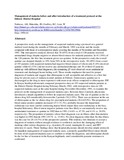| dc.description.abstract | A prospective study on the management of suspected malaria using a protocol on a general medical ward during the months of February and March, 1992 was done and the results compared with those of a retrospective study covering the months of November and December, 1991. The retrospective analysis showed that 78 (65%) from a total of 120 patients received antimalarial drugs despite negative or absent blood smears for malarial parasites. In 41 (34%) of the 120 patients, the first line treatment given was quinine. In the prospective study the overall quinine use dropped sharply to 19% from 54% in the retrospective study. 94 (49%) from a total of 193 patients with suspected malaria had negative blood smears of whom only 8 (4%) received quinine while 63 (33%) did not receive any antimalarial therapy and 38 of these 63 patients ended up with different final diagnoses; the remaining 25 were observed on no antimalarial treatment and discharged home feeling well. These results emphasize the need for proper diagnosis of malaria and suggest that chloroquine is still acceptable and effective as a first line drug for proven cases of malaria in adult patients in Eldoret. Unnecessary quinine use is discouraged as the drug is more expensive with more toxic effects compared to chloroquine.
PIP:
In Kenya, health professionals compared prospective data on 193 suspected malaria patients at the Eldoret District Hospital during February-March, 1992, with retrospective data on 120 suspected malaria cases at the same hospital during November-December, 1991, to examine the protocol on the management of suspected malaria cases. Between these 2 periods, physicians introduced a simple algorithm to follow in suspected malaria cases. The use of quinine as the 1st choice drug fell considerably between the 2 periods (54.2-19%). There was an increase in the use of chloroquine as the 1st choice drug for uncomplicated malaria (38.4-63.9%). The proportion of blood smear positive patients increased (27.5-51.3%), probably because the department technician was more careful conducting repeat blood smears than were technicians at the busy hospital laboratory. Blood smear negative patients were less likely to automatically receive any antimalarial treatment or quinine in 1992 than in 1991 (14.6% vs. 47.5% and 4.1% vs. 30.9%, respectively). The proportion of patients whose final diagnosis was an illness other than malaria was higher in 1992 than in 1991 (19.7% vs. 15.8%). No clear diagnosis other than flu-like illness was the case for 28 (14.5%) of the prospective patients. The tendency for clinicians to accept a diagnosis of malaria without enough evidence to confirm it can have the damaging effect of masking other serious diagnoses (e.g., dysentery [8 cases], meningitis [6 cases], and HIV infection [2 case]). These findings show that hospital physicians should develop simple protocols for inpatient management of suspected malaria cases, a properly quantified blood smear should be done of all suspected malaria cases to confirm or refute the diagnosis, and chloroquine should be the 1st line of treatment in the Kenyan highlands, until considerable parasite resistance is confirmed. | en |


